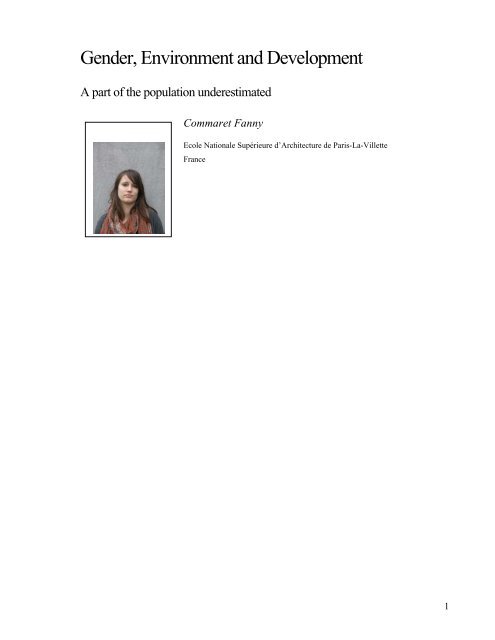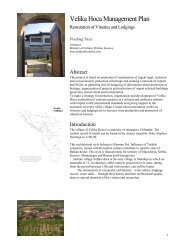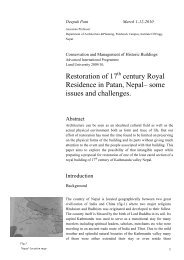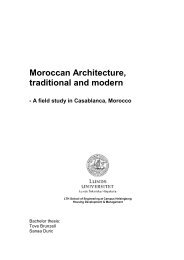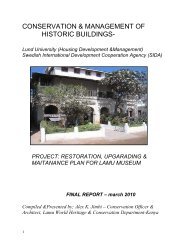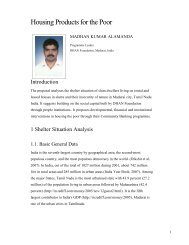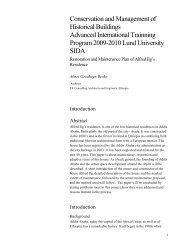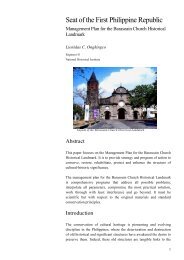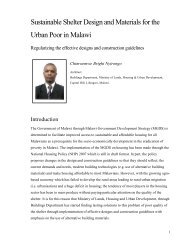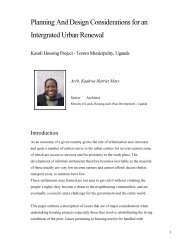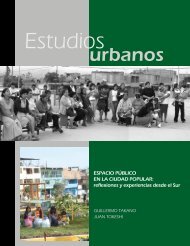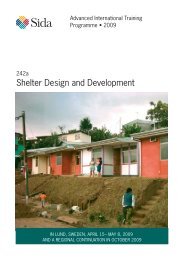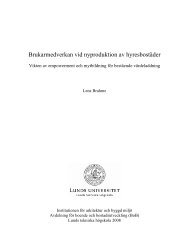Sample - Individual Work paper - HDM
Sample - Individual Work paper - HDM
Sample - Individual Work paper - HDM
You also want an ePaper? Increase the reach of your titles
YUMPU automatically turns print PDFs into web optimized ePapers that Google loves.
Gender, Environment and Development<br />
A part of the population underestimated<br />
Commaret Fanny<br />
Ecole Nationale Supérieure d’Architecture de Paris-La-Villette<br />
France<br />
1
Commaret Fanny<br />
1 Urban Shelter Design Development<br />
During the last century, the world has changed a lot. The industrialisation in the<br />
early 30’s metamorphosed the urban face. The cities started to grow and to<br />
modernise in the most advanced countries. The “North” with the colonies transmit<br />
some of these ideologies to the “South”. With the World wars, the goals of the<br />
European cities changed, the purpose is now to reconstruct as in the rest of the<br />
world it is to urbanise. Thousands of people have to be relocated, fast and easily.<br />
Lot of different urbanism theories emerged trying to find new solutions to the<br />
urban situation. In Europe the functionalism is the new model of planning. The<br />
urbanists and architects are united around one common idea, rationalise the cities<br />
and organise it by functions. This creates in France the “Grands Ensembles” with<br />
Le Corbusier’s “cite radieuse”. These ideas are a total disaster that we can observe<br />
now. The people that are living there (most of time low incomes earners) are far<br />
away from the center of the city, excluded and turn into themselves. This kind<br />
large scale, high rise concrete buildings without any context and surrounding<br />
emerged everywhere in Europe in the 50’s and the effects (Suburban crisis) are<br />
visible since a few years. This was in general linked to the new economical model<br />
the Keynesianism.<br />
Le Corbusier – La ville Radieuse Emile Aillaud- Les Courtillières<br />
Paper project 1 Pantin, France 2<br />
In Europe in the 60’s a huge crisis start to be visible, the post war generation<br />
does not agree with the old generation. The movement grows and grows to<br />
1 http://hida35.blogspot.fr/ Mai 2012<br />
2 http://www.archivesnationales.culture.gouv.fr Mai 2012<br />
2
Gender, Environment and Development, a part of the population underestimate<br />
explode in May 1968 at the same period as the economical crisis (petrol crisis<br />
1973).<br />
This leads to the liberation of the colonies (the decolonisation from the early<br />
60’s). From this period, the cities started to evolve very differently in the “South”<br />
and in the “North”.<br />
In the 70’s, the “South” had to readjust economically and socially. At the same<br />
period, the world economy is falling. The conjuncture is hard and the priorities of<br />
the “South” countries is not in the development of the cities. At the same time in<br />
the “North”, the automobile invades the cities which are readapted to that new<br />
way of circulation. The petrol, textile, and metal crisis questioned the model of the<br />
functionalist cities. The optimisation of this model seems not effective anymore.<br />
The post colonialism changed also a lot the cities in the “South”, continuing to<br />
use the western master planning model and trying to adapt them at their new<br />
society. During the inter-war and post-war periods, master plans were usually<br />
prepared by foreign planners 3 . The model is often not well adapted to the climate<br />
and society and they function really poorly. “As in Western Europe, master<br />
planning activity here peaked in the two decades following the second world war.<br />
This was linked to the need for reconstruction (...), the redistribution of population<br />
related to partition and decolonisation, the creation of new capitals for the newly<br />
independent countries, and as a response to rapid population and urban growth.”1<br />
The urban growth is an important issue in urbanisation, it has been slowly<br />
admitted in the “Northern” countries but in the “Southern” the peak has been<br />
really fast. “UN projections suggest that over the next 30 years virtually all of the<br />
world’s population growth will occur in the urban areas of low- and middleincome<br />
countries.”<br />
4<br />
The development of the cities in the developing countries has<br />
been quite fast and the authorities had to deal with the overpolulation and the lack<br />
of dwellings. The rural families moved with the hope for better opportunities that<br />
most of time they did not find. The number of informal settlements increased a lot<br />
during the last decades and the cities now reached a breaking point. In Metro<br />
3 Planning and Housing in the Rapidly Urbanising World, Paul Jenkins, Harry Smith ans Ya Ping<br />
Wang<br />
4 Task force : Improving the lives of slum dwellers, a home in a city, millennium project<br />
3
Commaret Fanny<br />
Manila, the situation is bearely livable, the traffic is present everywhere, the<br />
informal settlements are almost half of the city. The authorities, because of<br />
partnerships, prefer to build everything in concrete rather than to search for new<br />
innovations and techniques that could cost less and be more effective. Economical<br />
goals are holding the residents in hostage. The early ideas of self-build housing<br />
are promising but not developed enough and not accepted everywhere.<br />
Even if the situation is most of time getting better and the developing countries<br />
are starting to rethink the cities, the inequalities are still more than obvious and<br />
the standard of living is really low.<br />
The new criterias of good planning and housing are now sustainability and<br />
quality. The difficulty is that, most of time, sustainability costs a lot but as long as<br />
a design is good, it is at my sense always sustainable because it allows comfort of<br />
living without increasing the resources needed. With those goals, the emergence<br />
of the “Habitat Agenda” tries to focus on sustainability and urban development<br />
but also on urban poverty and slum eradication. “The re-emergence of global<br />
conferences in the 1990s reflected the changing global political and economic<br />
context. (...) The two principals emerging themes of this normative agenda at the<br />
turn of the millennium were a renewed focus on alleviating poverty and the role of<br />
establishing human rights, including in the human settlements sector.”3<br />
With these conferences, an alliance between governments is created with the<br />
same goals and hopes. Considering these goals, they defined targets to reach<br />
within the next few years. They are called the Millennium Development Goals<br />
(MDGs). “The agency UN-Habitat has published two recent reports on how it<br />
interprets the MDGs in relation to shelter and human settlements (...) and these<br />
represent important summaries of current dominant approaches to planning and<br />
housing from the international perspective.” 5<br />
A lot of new goals and worries have emerged during the 1990s and continued<br />
into the new millennium. It shows that people start to be conscious and aware of<br />
what’s going on and what are the issues. This could lead to new masterplanning<br />
and I think it is the role of our generation of architects to resolve these problems.<br />
5 Planning and Housing in the Rapidly Urbanising World, Paul Jenkins, Harry Smith ans Ya Ping<br />
Wang<br />
4
Gender, Environment and Development, a part of the population underestimate<br />
2 Factors Shaping Urban Shelter Design<br />
From my studies and my social environment I am used to think a lot in term of<br />
social aspects. I think that if a community is working, the people can do great<br />
things together. The only thing they need is the possibilities to do so and some<br />
help. In Metro Manila, the women in low income families are most of time not<br />
working for salary and are raising the children at home. In my idea, their potential<br />
is underestimated.<br />
“Since the late ‘80’s the link between Gender, Environment and Development<br />
(GED) has emerged as an area of special interest for researchers, policy makers<br />
and activists”. 6 To give a clue of what is the link between these three “words”, we<br />
should start by defining them. “The term of Gender as it is used here, refers to<br />
culturally and historically specific concepts of feminity and masculinity, and the<br />
power relations between men and women ( Schrijvers 1993).”4 Gender has to be<br />
differenciated from sex. It has to be connected with the social construction of sex<br />
roles and relations between the sexes. Gender could say that if women are<br />
actually more involved in taking care of plants and environment, it is not because<br />
it is in their genes but because it is how they have been told. Men and women all<br />
over the world have their own spheres of interests and their own attributed tasks.<br />
The term environment refers to natural resources and could also be cover by<br />
the therm of ecology.<br />
The term development refers to “economic, socio-political and cultural<br />
processes of change in human societies (Schrijvers 1993).”4 In this essay the term<br />
development is associated to the development of the way standard of living and to<br />
the income of the family. At the larger scale it is linked to the enrichment of a<br />
neighbourhood and a disctrict.<br />
“The literature shows that three strongly interrelated factors are important to<br />
explain why gender, environment and development are so closely connected.<br />
These are the sexual division of labour, the “feminization of poverty” and gender<br />
ideology”.4 From sexual division of labour, especially in poor rural environment,<br />
the women are the ones taking care of the land, they are the ones having the<br />
6 Gender Environment and Development, a guide to the literature, Heleen van den Hombergh<br />
5
Commaret Fanny<br />
knowledge and they are more able to protect the land. Also because of the<br />
feminization of poverty, women and especially single mothers need to produce<br />
food as an additional source of income. The gender ideology can explain also that<br />
the women are conditioned to stay at home to raise the children so they are close<br />
to the land around the house and can make this duty at the same time as looking<br />
after the children.<br />
My statement is that the role of women in Metro Manila is underestimated and<br />
they could be an important source of income for the families. “To some extent, the<br />
factors mentioned above: sexual division of labour, feminization of poverty and<br />
gender ideology are also important for the relationship of Northern women to the<br />
environment. In the industrialized countries, as well as in the South, women are<br />
responsible for caring and feeding, they are overrepresented in the low income<br />
categories, and underrepresented in decision-making bodies.” 7<br />
At the first world conference on women, 1975 in Mexico-city, the « women<br />
and environment » issue was brought into public consciousness by the indian<br />
physicist Vandana Shiva. 8 She reported the Chipko community exemple in the<br />
Himalya. This story became after one of the major leading exemple in term of<br />
“Gender and environment” theories. “. The Chipko women tried to protect the<br />
trees of the woodlands they owned in common against commercialization and<br />
destruction by embracing them. The wood was their reservoir of nutrition,<br />
materials for house building and for small goods. Governmental and industrial<br />
interests denied the Chipko people their traditional right to the commons and tried<br />
to expropriate them.” 6<br />
This proves that in allowing a community life by the design, it is possible to<br />
make much more. One people alone can do a few things but if more people are<br />
united with the same ideas and the same goal they can have a way bigger impact<br />
and maybe leave a foot print in the world for many years. This kind of movement<br />
of women has been during the recent decades more and more common. This is<br />
7 Gender Environment and Development, a guide to the literature, Heleen van den Hombergh<br />
8 Research on Gender, the Environment and Sustainable Development Studies on Gender Impact<br />
Assessment of the Programmes of the 5th Framework Programme for Research, Technological<br />
Development and Demonstration<br />
6
Gender, Environment and Development, a part of the population underestimate<br />
also linked to the feminist movement and especially the “Eco-feminism”. My goal<br />
here is not to understand why women are more involved in environment<br />
protection and taking care but to state this aspect and to think how it is possible to<br />
emphasise it. The difference between the male and female sexual organs seems to<br />
be a reason for centuries of social construction of gender. If women are indeed<br />
closer to nature because of that, a good idea could be to think about it in the<br />
design.<br />
In the process of building low income housing, the women shouldn’t be forgot.<br />
By involving them in the neighbourhood life, they can allow the entire<br />
neighbourhood to upgrade. Since decades, sustainability and ecology are at the<br />
center of all preoccupation and especially in architecture. By creating urban<br />
agriculture in low income housings, the families can improve their income by<br />
selling the products or keeping them for the use of the family. However, this<br />
practice can’t be isolated and has to be part of a bigger movement and ideology.<br />
3 Design of Sustainable Shelter and Neighbourhoods<br />
“We must first eradicate poverty before we can worry about the environment!”<br />
“On the contrary: environment degradation is the major cause of poverty in the<br />
first place!”<br />
“Once we realise that “the environment” actually means soil- to grow food; waterto<br />
drink, wash and irrigate crops; and air to breathe, and a host of natural food and<br />
medicinal products, it becomes clear that preserving “the environment” actually<br />
means safeguarding food production; sustaining livelihoods and preserving health.<br />
Poverty reduction, economic growth and the maintenance of life-supporting<br />
environmental resources are therefore inextricably linked.”. 9<br />
Considering that preserving environment is not just another hipster movement,<br />
authorities should be a lot more conscious about the goals behing this. Urban<br />
agriculture should be introduced in the developing countries, allowing the families<br />
to increase their income. At the same time, the community could organize<br />
9 Poverty-Environment-Gender Linkages, DAC Journal 2001, Volume 2, No. 4<br />
7
Commaret Fanny<br />
infrastructures where women can take turns in children’s supervision. That<br />
organization can allow more time for the women. Also by involving the children<br />
in the activities, they can be introduced to the basis of agriculture. The laundry is<br />
also an activity that women are doing together if they can. By building facilities<br />
where they can buy common washing machines with their capital, it will<br />
savemoney, electricity and space. An outside space should also be provided. The<br />
rain water should at the same time be collected in order to reuse it for urban<br />
agriculture and laundry rooms. Allowing more space for community living can<br />
have a big impact on the standard of the neighbourhood.<br />
4 The Role of Architects<br />
The role of architects is to provide good quality of living for the population. Every<br />
country is different and the population have different criterias of what is a good<br />
quality of living. The future inhabitants should be more involved in the primary<br />
design of the neighbourhood, it is a good way to know what is important or not.<br />
During a field trip with the studio Urban Shelter 2012 of Lund University in the<br />
Philippines, I observed that some offices (TAO Philippines) were working with<br />
the population, making workshops and conferences. People should be tought how<br />
to take care of the environment and how to take advantage of reusing water,<br />
composting and practicing urban agriculture at the same time. In one of the<br />
project we visited (St Hannibal), the inhabitants, before moving in, had to sign a<br />
chart saying that they will have to take care of plants. In doing that, the population<br />
started getting interested. After the construction, every month, or almost,<br />
conferences are held in a common room inside the neighbourhood.<br />
In France, most of time the population is not involved in the design and<br />
authorities think that they do not need to learn about anything. However, I had the<br />
occasion last year to be involved in an interesting project. It was a creation of an<br />
elderly house for feminist women. Because of legislation, it took some time for<br />
the authorities to accept such a community but the result is quite interesting and<br />
the old women participated a lot. Involving the population is always the beginning<br />
of a bigger scale dynamique and that can have a lot of influences on the every day<br />
life.<br />
8
Gender, Environment and Development, a part of the population underestimate<br />
References<br />
http://hida35.blogspot.fr/ Mai 2012<br />
http://www.archivesnationales.culture.gouv.fr Mai 2012<br />
Planning and Housing in the Rapidly Urbanising World, Paul Jenkins, Harry<br />
Smith ans Ya Ping Wang<br />
Task force : Improving the lives of slum dwellers, a home in a city, millennium<br />
project<br />
Gender Environment and Development, a guide to the literature, Heleen van den<br />
Hombergh<br />
Research on Gender, the Environment and Sustainable Development Studies on<br />
Gender Impact Assessment of the Programmes of the 5th Framework Programme<br />
for Research, Technological Development and Demonstration<br />
Poverty-Environment-Gender Linkages, DAC Journal 2001, Volume 2, No. 4<br />
9


